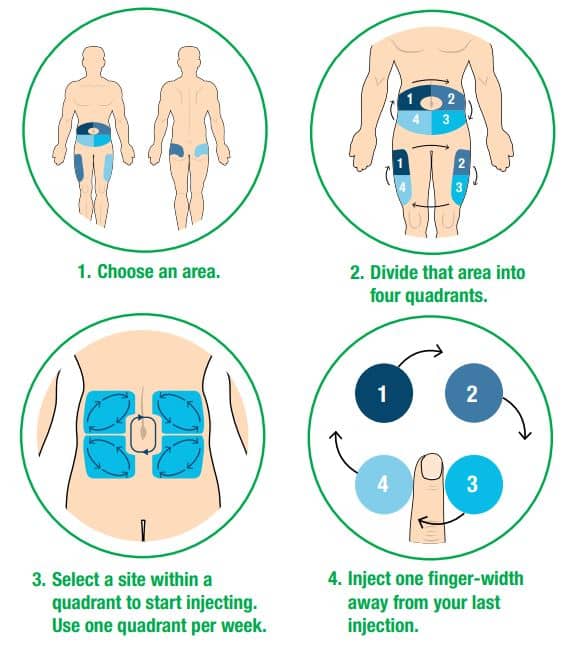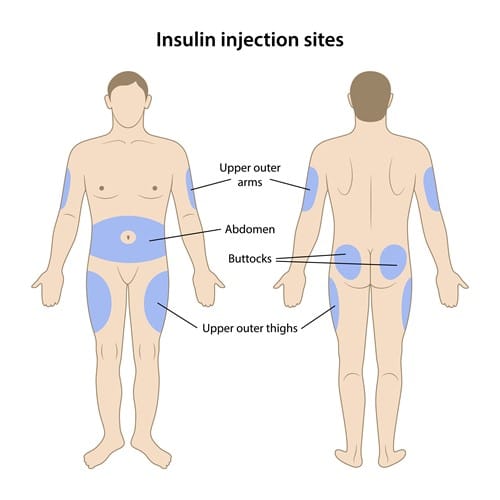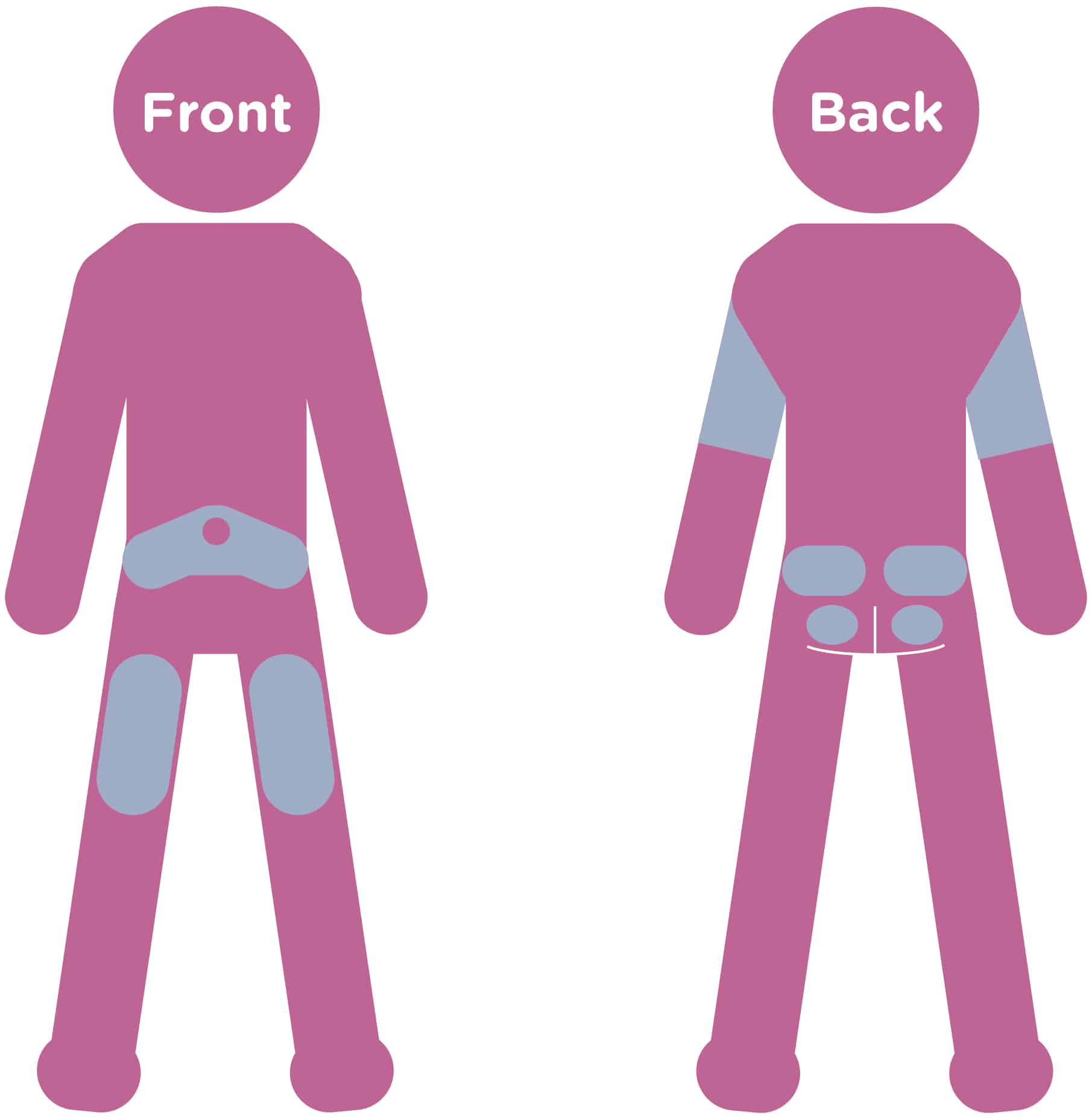Lower Back Hips Or Buttocks
The final site for administering an insulin injection is the lower back or hip.
To administer an injection here, draw an imaginary line across the top of the buttocks between the hips.
Place the needle above this line but below the waist, about halfway between the spine and the side.
As with the upper arm, this site is very difficult to use for self-injection and may require another person for administration. When injecting into the buttocks, avoid the lower part.
The body absorbs insulin at different speeds from each of the sites. This information can be useful when planning insulin injections:
- Abdomen: Insulin enters the bloodstream most quickly after an abdominal injection.
- Upper arms: The body absorbs insulin with moderate speed but slower than an injection in the abdomen.
- Lower back and thighs: Insulin enters the bloodstream most slowly from these sites.
- Administer rapid-acting insulin into the abdomen right after a meal for the fastest results.
Inject long-acting and intermediate-acting insulin into the other sites, as rapid absorption would reduce the effectiveness of these types. Insulin works more efficiently over the entire time it needs to because of the slower absorption rate.
Exercise can increase the absorption rate of insulin. If planning a workout or physical activity, account for these when planning injections.
Wait to for at least 45 minutes after the injection to exercise a part of the body that is near the injection site.
How Much Insulin To Take Per Carb
The average person will take about 1 unit of insulin for every 12 to 15 grams of carbohydrates consumed.
There is some variation to this, depending on how sensitive you are to insulin. For some people, this range is 1 unit for every 6 grams of carbohydrates, while for others, its 1 unit for every 30 grams of carbohydrates.
Tips For Choosing Sites
Fast insulin absorption is important to reduce after-meal blood sugars.
Therefore, you should inject your breakfast and lunch, and maybe dinner bolus doses into your abdomen. Do this unless instructed otherwise by a healthcare provider, or if you have an increased risk of low blood sugar or reactive hypoglycemia,
It is not advised to inject your breakfast insulin in the abdomen one day and into the thigh the next day. If possible, be consistent within each site and rotate accordingly.
Long-acting or bedtime insulin could be injected into the thigh, buttocks, or upper arm so that the absorption can happen gradually, covering your insulin needs throughout the night.
Ultimately, what’s most important is that you have access to a site and are consistent. The choice is always yours.
Don’t Miss: 14 Day Diabetic Meal Plan
Can I Reuse My Syringe
If you use your needle or syringe multiple times, there are the following risks:
- The tip of the needle becomes blunt after just one use, the sliding layer on the tip may become worn and the tip of the needle may be deformed:
- injections hurt more.
- very small skin lesions or bruising may occur.
What Are The Side Effects Of Human Insulin

Some possible side effects of insulin include:
- Lumps, pits, swelling, redness or itching at the injection site.
A note from Cleveland Clinic
Insulin is an essential hormone that helps you stay healthy and keeps your body working like it should. If your body isnt able to make enough insulin, your provider can prescribe human-made insulin as a diabetes treatment. Follow your providers instructions carefully when giving yourself insulin. Call your provider or seek medical help right away if you have serious side effects from insulin. To stay healthy and lower your risk of insulin-related health problems, eat right, maintain a healthy weight and exercise regularly.
Last reviewed by a Cleveland Clinic medical professional on 03/07/2022.
References
You May Like: Continuous Glucose Monitoring For Dogs
Dont Switch Your Insulin Dose Or Stop Taking It Without Seeing Your Doctor First
Switching your insulin medication or changing the dose without asking a doctor can put you at risk for serious side effects and complications.
If you have type 2 diabetes, you should be seeing your doctor or endocrinologist for a checkup roughly every 3 to 4 months. At your appointment, your doctor can assess your individual insulin needs and give you proper training on new doses or dosing methods.
What Is Blood Glucose Monitoring
People use blood glucose monitoring to regularly test glucose levels in the blood.
It is an essential part of effective diabetes control. Many people with diabetes must check several times each day to plan for activities and meals, as well as scheduling doses of medication or insulin.
A person can test their blood glucose levels with a glucometer. They usually come with lancets, or tiny needles, a logbook to record results, and test strips.
You May Like: Herbal Medicine For Diabetes In The Philippines
Importance Of Site Rotation
Injecting into the same exact spot on the same exact site over and over again can cause the skin to develop hard lumps or extra fat deposits. These lumps can be unpleasant looking, and they can change the way insulin is absorbed and make it more difficult to control your blood sugar.
Over time, the thickened skin may lose nerve endings and as a result, shots may become painless. A painless injection may seem like a good thing, but it can be a sign that the skin is becoming damaged.
The best way to control blood sugar is to aim to use the same site at the same time of day daily and to rotate within that site. For example, if you take mealtime insulin, inject it daily into your abdomen for breakfast, but rotate within that site daily. And if you take long-acting insulin at night, you can use your thigh, for example, but rotate within that site.
How To Inject Insulin
Before injecting insulin, be sure to check its quality. If it was refrigerated, allow your insulin to come to room temperature. If the insulin is cloudy, mix the contents by rolling the vial between your hands for a few seconds. Be careful not to shake the vial. Short-acting insulin that isnt mixed with other insulin shouldnt be cloudy. Dont use insulin that is grainy, thickened, or discolored.
Follow these steps for safe and proper injection:
Read Also: Best Protein Powder For Type 2 Diabetes
How Is Insulin Taken
There are two ways to give yourself insulin: from vials or with pens. If you are using a vial, you will also need syringes. If you are using a pen, you will also need pen needles. Both the syringes and the pen needles can be thrown away after you use them. It is common to take more than one type of insulin. Mealtime insulin is taken before meals to help manage food-related rises in blood glucose . Long-acting insulin helps to manage blood glucose throughout the day and needs to be taken at the same time every day. Your health care provider will tell you when to take your insulin and how much to take.
Dont Wait More Than 15 Minutes To Eat After Taking A Mealtime Insulin
Rapid-acting insulins, also known as mealtime insulins, were designed to be taken right before you eat to help control your blood sugar more effectively.
As the name suggests, rapid-acting insulin starts to work rapidly in the bloodstream. If you wait too long to eat, your blood sugar can get too low. This puts you at risk for hypoglycemia.
If you cant eat a meal after youve already taken your mealtime insulin, you should carry around a carbohydrate source to avoid hypoglycemia. These include:
- glucose tablets
Calculating the right dose of mealtime insulin can be complicated at first, especially if you dont know how many carbohydrates youre going to be eating at your next meal.
Try not to panic if you realize you took too much or too little insulin.
If you think youve taken too much insulin, eat some rapidly-absorbed carbs, like juice or glucose tabs. You may also want to contact your doctor.
If youve taken a lot more than you need, like double or triple the correct dose, have a friend or family member get you to a hospital. You may need to be observed for severe low blood sugar.
If you think youve taken too little insulin or forgot to take it at all before your meal, measure your blood sugar. If it gets too high, you may need to take short or rapid-acting insulin as a corrective measure to lower your blood glucose levels. If youre at all unsure about the dose, seek advice from your doctor or diabetes care team.
You May Like: Medicare Part D Insulin Coverage
Rotate Insulin Injection Sites
Because you will be injecting insulin on a regular basis for diabetes, you need to know where to inject it and how to rotate your injection sites. By rotating your injection sites, you will make your injections easier, safer, and more comfortable. If the same injection site is used over and over again, you may develop hardened areas under the skin that keep the insulin from being used properly.
Important: Only use the sites on the front of your body for self-injection. Any of the sites may be used if someone else is giving you the injection.
Follow these guidelines:
- Ask your doctor, nurse, or health educator which sites you should use.
- Move the site of each injection. Inject at least 1 1/2 inches away from the last injection site.
- Try to use the same general injection area at the same time of each day . Note: The abdomen absorbs insulin the fastest, followed by the arms, thighs, and buttocks.
- Keep a record of which injection sites you have used.
When Should I Call My Doctor Or Diabetes Care Team Provider

- You feel or see hard lumps in your skin where you inject your insulin.
- You think you gave yourself too much or not enough insulin.
- Your injections are very painful.
- You see blood or clear fluid on your injection site more than 1 time after you inject insulin.
- You have questions about how to give the injection.
- You cannot afford to buy your diabetes supplies.
- You have questions or concerns about your condition or care.
You May Like: Does Diet Coke Raise Blood Sugar
Do I Need To Monitor My Blood Sugar Level
Yes. Monitoring and controlling your blood sugar is key to preventing the complications of diabetes. If you dont already monitor your blood sugar level, you will need to learn how. Checking your blood sugar involves pricking your finger to get a small drop of blood that you put on a test strip. You can read the results yourself or insert the strip into a machine called an electronic glucose meter. The results will tell you whether your blood sugar is in a healthy range. Your doctor will give you additional information about monitoring your blood sugar.
Best Place To Inject And Absorption
The best place to inject insulin will depend on what type of insulin you are using and when you are using it. Your body absorbs insulin differently depending on where it is injected. Typically, insulin absorption is fastest in the abdomen, somewhat slower in the upper arms, even slower in the thighs, and slowest in the buttocks.
Recommended Reading: How To Use Barley For Diabetes
Get Everything You Need
- Syringe, with needle.
- Alcohol swabs Youll want to wipe off the top of the bottle as well as the skin around the injection spot.
- A sharps container, which is basically any sturdy box with a lid where you can keep the used needles and syringes. There are rules about how and where you can dispose of these, so check in your area for what is most convenient for you. Keep in mind that you may need a specific type of container depending on which disposal option you choose.
How Do You Inject Insulin With A Syringe Step
You may take insulin using a syringe that you fill from a vial. Ask your doctor or nurse to show you how to do it correctly. Follow their directions carefully. Here is a step-by-step summary of how you inject insulin from a vial using a syringe and needle.
Don’t Miss: Diabetes And Metabolism Patient Portal
Reasons To Avoid A Particular Site
If you develop lumps and bumps at injection sites, avoid the area of the bump for several months because that area will absorb insulin differently and this can affect your blood sugar levels.
In addition, avoid using sites where you plan on exercising, as this can increase the risk of hypoglycemia due to increased absorption.
Lastly, avoid injecting into moles or scar tissue, as these can also affect insulin absorption.
When Do I Take Rapid
You should inject rapid-acting insulin no more than 15 minutes before you eat. Your doctor will tell you how much insulin to inject. Remember, you should not wait more than 15 minutes to eat after you take this insulin shot.
Rapid-acting insulin can be more convenient to take than regular insulin. With regular insulin, you inject the insulin and then wait 30 to 60 minutes before eating. Many people find it hard to time their meals around regular insulin injections. Sometimes they end up eating too soon or too late. Then they dont achieve the best blood sugar control. Since rapid-acting insulin is taken so close to mealtime, it may help you control your blood sugar more effectively.
Read Also: Cheapest Insulin In The World
Also Check: How To Fix Low Blood Sugar Levels
How Do You Take Insulin
Your healthcare provider may prescribe insulin to lower your blood glucose and keep you healthy. We refer to the insulin available now as human insulin because it’s made to act just like the insulin thats naturally produced.
You can take insulin in a variety of ways based on your needs and lifestyle. Your healthcare team will work with you to determine which is best for you. You may:
- Give yourself a shot using an insulin pen or a vial and syringe.
- Receive doses through an insulin pump. The pump attaches to your body with a small catheter under your skin and delivers the insulin.
- Inhale it as a powder.
Do Tell Friends And Family That Youre Taking Insulin

Its a good idea to teach your friends, colleagues, and family members about insulin and its potential side effects. If you do end up taking too much insulin and having a hypoglycemic episode, they should know how to help.
If you become unconscious, a friend or family member can give you a shot of glucagon. Talk with your doctor about keeping a supply of glucagon on hand and learning when and how to use it.
Recommended Reading: Diagnosing Type 1 Diabetes In Children
What Is Different About Insulin Lispro
Insulin lispro is a new type of insulin. It starts working sooner than other insulin types. It also reaches peak activity faster and goes away sooner. Insulin lispro helps keep your blood sugar level from going too high after you eat. To keep your blood sugar level steady, your doctor will probably prescribe either a longer-acting insulin or another drug for you to take each day in addition to the insulin lispro.
If you need to mix insulin lispro with a longer-acting insulin, it’s best that you mix insulin lispro only with Humulin U or Humulin N, which are brand names for certain longer-acting insulins. Insulin lispro should always be drawn into the syringe first. This will keep the longer-acting insulin from getting into the insulin lispro bottle.
Can You Inject Insulin Into Muscle
The short answer is yes, but you shouldnt inject insulin into muscle unless its very intentional and you understand the consequences and risks.
Injecting insulin directly into muscle is going to completely change how quickly it is absorbed into your bloodstream and how it quickly it starts affecting your blood sugar levels.
The onset, peak, and duration will all change when insulin is injected directly into muscle tissue.
Don’t Miss: Is Weight Watchers Good For Type 2 Diabetes
How Do I Calculate How Much Insulin To Take
In people who do not have diabetes, their bodies release insulin in response to the foods they eat. This is because many foods contain carbohydrates. Some examples include bread, sweets, fruits, and even vegetables.
Your body breaks carbohydrates down into smaller building blocks, like glucose. You need insulin to use this glucose for energy. If your body cannot make or use insulin effectively, youll need to inject it to process your food for energy.
Calculating how much insulin to take is usually based on two considerations:
- Basal insulin dose. A basal insulin dose is an amount that you give yourself daily regardless of the foods you eat.
- Bolus insulin dose. A bolus insulin dose helps correct or anticipate the carbohydrates you eat throughout the day. You will usually correct this with a bolus dose of rapid-acting insulin.
Anticipating a bolus dose is where insulin administration can get tricky. When you give yourself insulin, you are estimating how many units of insulin it will take to process the carbohydrates you eat.
The University of California, San Francisco states that, as a general rule, 1 unit of insulin will process anywhere from 12 to 15 grams of carbohydrates and lower your blood sugar by about 50 milligrams per deciliter .
Since the human body is so complex, not all people will process insulin the same way. Factors like time of day, stress levels, and physical activity can make these numbers more difficult to predict.